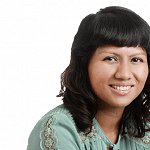A "strange mix between a fashionista and an anthropologist" is how Mexican fashion designer Carla Fernandez describes herself.
For the past two decades, Fernandez has been helping to keep traditional Mexican fashion techniques alive by working with people from the indigenous communities in Mexico for her contemporary and avant-garde designs.
The daughter of a historian and a fashionista, she grew up appreciating the beauty of traditional designs.
"I became very aware of the Mexican native communities. I saw the girls dressed so beautifully. That's how I began to understand the elegance and fashion of indigenous communities in Mexico," says the 43-year-old, who studied fashion design and art history in school.
She will debut the spring/summer 2017 collection of her label in Singapore on June 30, as part of The O.P.E.N, a pre-festival of the Singapore International Festival of Arts. She will also deliver a 75-minute talk on July 1 about her approach to fashion.
On July 3, she will conduct a two- hour "square root" tailoring workshop, recommended for children aged seven to 16. It will teach them to create garments using the traditional way of making Mexican clothes with woven square cloths.
-
BOOK IT /DANCES AND CEREMONIES: SPRING/SUMMER 2017
-
WHEN: June 30,10pm
ADMISSION: Free with O.P.E.N pass, which costs$45
A CONVERSATION WITH CARLA FERNANDEZ
WHEN: July 1, 7.30pm
ADMISSION: Free with O.P.E.N pass
SQUARE ROOT TAILORING WORKSHOP FOR KIDS AND TEENS
WHEN: July 3,2pm
ADMISSION: Free with$45 O.P.E.N Pass forone adult and two children (aged 12 and below); free with $25 O.P.E.N concession pass (13 to 16 years old)
All events take place at 72-13, MohamedSultan Road. For more information,go to www.sifa.sg/theopen
A design workshop for adults is already fully subscribed.
Fernandez is excited to present her fashion show, which takes the form of an hour-long performance.
Models will dance to the choreography of New York-based dancers Silas Riener and Rashaun Mitchell, a mix of traditional dance from the Mexican indigenous communities and contemporary dance.
There will be 35 outfits featured, the result of working with 11 different tribes and communities in Mexico, such as the Hueyapan community from Puebla. The techniques used in creating the outfits for the show include Punto De Cruz or Mexican-style embroidery and handcrafted leather.
Mexican artist Pedro Reyes, who is also Fernandez's husband, has created four 2.5m-high stone totem poles which will be part of the installation in the show.
The couple have two children, aged nine and 10.
Her eponymous fashion brand, which has four stores in Mexico, has two lines - a handmade range and a ready-to-wear one - which she says is necessary for it to be able to compete as a fashion brand.
Besides selling clothes, Fernandez has also exhibited her work in museums, including a solo show at the Isabella Stewart Gardner Museum in Boston, United States.
She won the Prince Claus Award in 2013, which honours individuals and organisations in Africa, Asia, Latin America and the Caribbean for outstanding achievements in the field of culture and development.
She hopes to raise awareness of Mexico's fashion heritage, which has been referenced by high-fashion brands such as Christian Lacroix and Dolce & Gabbana.
"Mexico is so vast and we have so many different communities and attires," she says.
"Instead of just getting inspired by it, we decided to do it together with the communities that this clothing belongs to."
She and her team spend time in the villages working with the local communities. Eighty-five per cent of these artisans are women, who work at home or in workshops.
The handmade pieces they make can take up to three months to complete, using techniques such as weaving, dyeing and embroidery.
Fernandez also ensures that they get fairly compensated, as some of these artisans work with multiple brands besides hers.
She says: "Previously, they might take two months to make a blanket and earn 2,000 pesos (S$146).
"Now, they can earn that amount in four or five days. That's how it should be.
"I feel very happy that I can keep the community going, help them take care of their families and sustain the balance in the countryside."


